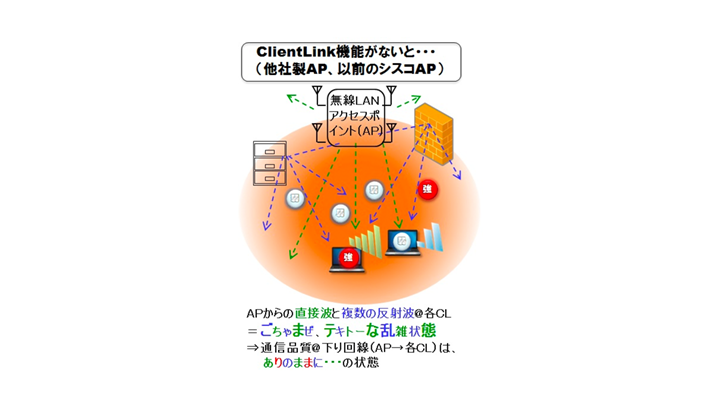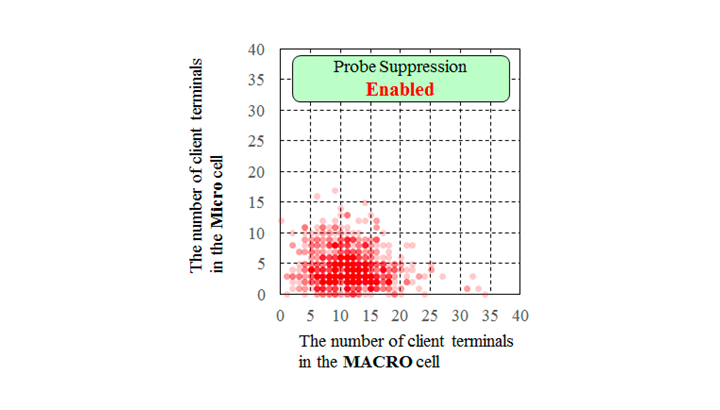- ナレッジセンター
- 匠コラム
Cisco ClientLink by Aironet access points, Forever!
- 匠コラム
- プロダクト
- ネットワーク
Advanced Technology Engineering Department1,
Business Development Division
Takashi Matsudo
This report presents the experimental results of the performance of Cisco ClientLink supported on Cisco Aironet access points.
Note: The original in Japanese of this report was opened to the public in Mar.15, 2017 [1].
Introduction
I took part in "Enterprise Networking Partner VT - April 2019" held by Cisco systems using Webex to get information on new Cisco access points for Wi-Fi6(IEEE802.11ax). At the seminar "Introduction to Wi-Fi 6," I learned that the new access points are Cisco Catalyst 9100 access points. I felt a little bit lonely that the name of Aironet disappeared for access points. I also learned that only transmit beamforming specified by 11ax was in the new access points and that Cisco ClientLink [2], [3], [4], [5] was no longer supported on them. Currently, many access points and client terminals are both for 11ac and emerging 11ax. Cisco ClientLink ended its role because its primary role was to support 11a, 11g, and 11n client terminals as Cisco systems-proprietary transmit beamforming. However, I felt also a bit lonely without Cisco ClientLink.
Previously, when I experimented to confirm the performance of Cisco ClientLink in an indoor office environment, I was surprised at its great performance and reported results of the experiment in Japanese. Now, since I would like to express my appreciation to Cisco ClientLink, I will report in also English the great performance on Cisco ClientLink confirmed by the experiment.
What is Cisco ClientLink?
Cisco ClientLink is Cisco systems-proprietary transmit beamforming supported on Cisco Aironet access points connected to Cisco wireless LAN controllers. This function improves the communication quality of the downlink from the access point to the client terminal. Of course, Cisco Aironet access points support not only Cisco ClientLink but also a general transmit beamforming specified by the IEEE 802.11 standard.
The general transmit beamforming specified by the IEEE 802.11 standard requires, in addition to access points, client terminals to have special mechanisms supported by both hardware and software. On the other hand, since Cisco ClientLink is all handled by the access points side, no special mechanisms are required for 11g, 11a, 11n, and 11ac client terminals. In particular, the IEEE 802.11 standard couldn't specify the transmit beamforming for 11a and 11g, but Cisco ClientLink has made it possible. Detailed information for implementing Cisco ClientLink is not opened by Cisco systems. However, Cisco ClientLink improves the communication quality of the downlink from the access point to the client terminal for 11a, 11g, 11n, and 11ac.
Cisco ClientLink has a version number, which means supported client types.
Cisco ClientLink is for 11g and 11a clients [2].
Cisco ClientLink2.0 is for 11g, 11a and 11n clients [3].
Cisco ClientLink3.0 is for 11g, 11a, 11n and 11acWave1 clients [4].
Cisco ClientLink4.0 is for 11g, 11a, 11n, 11acWave1 and 11acWave2 clients [5].
Improvement effect part 1 of using Cisco ClientLink confirmed in the experiment
Figure1 shows power received at the client terminal for 11a on the downlink on a straight path in the indoor office environment, which is in line-of-sight propagation between the access point and the client terminal. The vertical axis is the power(dBm) received at the client terminal and the horizontal axis is the distance(m) between the access point and the client terminal. The access point was Cisco Aironet CAP3602E using Cisco ClientLink2.0 with four antennas(ANT2524DW-R). The distance between the antenna connector level of the CAP3602E and the floor was 1.55(m). The client terminal was a wireless LAN module for 11a with CCX version4 built into my PC, which was Intel PRO/Wireless3945ABG Network Connection. The distance between the top of the client terminal PC and the floor was 0.94(m). The power received at the client terminal was the power averaged over 10 frames transmitted from the CAP3602E with one command of "Linktest" [6]. The power received at the client terminals was measured about each 0.3(m).
A solid line shown in Fig.1 is the power received at the client terminal with using Cisco ClientLink 2.0 on the CAP3602E. On the other hand, a dotted line shown in Fig.1 is the power received at the client terminal without using Cisco ClientLink2.0 on the CAP3602E. To operate or stop Cisco ClientLink2.0 of the CAP3602E, I carefully used the special commands guided by a reference document [7]. In Fig.1, it is found that the transmission using Cisco ClientLink2.0 makes power received at the client terminal on the downlink increase as compared to the transmission without using Cisco ClientLink2.0.

Figure1 Power received at the client terminal for 11a on the downlink measured about each 0.3(m)
Improvement effect part 2 of using Cisco ClientLink confirmed in the experiment
When the client terminal cannot receive a data frame transmitted from the access point due to adverse effects, for example, multipath fading, the access point retransmits the data frame to the client terminal. For responsive and more comfortable communication, the number of times for retransmission of the data frame by the access point should be minimized.
Figure2 shows the frequency distribution of the number of frames retransmitted from the Cisco CAP3602E on the downlink for 11n in the indoor office environment. In Fig.2, the vertical axis is the number of frames retransmitted from the Cisco CAP3602E for 11n to a USB interface WLAN adapter(I-O DATA WHG-AGDN/US) for 11n, and the horizontal axis is the number of transmission antennas in the CAP3602E. The distance between the top of the client terminal of the USB interface WLAN adapter and the floor surface was 0.89(m).
A black histogram in Fig.2 is the frequency distribution of the number of frames retransmitted with using Cisco ClientLink 2.0 on the CAP3602E. On the other hand, a histogram marked by symbols of the dash in Fig.2 is the frequency distribution of the number of frames retransmitted without using Cisco ClientLink2.0 on the CAP3602E. It is found that the number of frames retransmitted from the CAP3602E in 11n is improved by using Cisco ClientLink2.0. As the number of antennas on the CAP3602E increases, the number of frames retransmitted from the CAP3602E using Cisco ClientLink2.0 decreases.

Figure2 Frequency distribution of the number of frames retransmitted on the downlink for 11n
Conclusion
I confirmed experimentally that Cisco ClientLink had a great performance. In our office environment, Cisco ClientLink on Aironet AP3802I is comfortably supporting us because client terminals for 11n are running yet. Also, by using "a Micro cell on a MACRO cell architecture" with the AP3802I which operates in dual 5 GHz band with enabled probe suppression, our wireless LAN has been operated comfortably even in a high-density environment [8].
In the near future, even if we replace the AP3802I with new access points, such as Catalyst 9100 access points [9], we will never forget Cisco ClientLink by Aironet access points. Thanks to Cisco ClientLink!
References
[1] Takashi Matsudo, (in Japanese) ” We have experimentally confirmed that Cisco ClientLink can improve wireless LAN communication quality.“, https://www.netone.co.jp/knowledge-center/blog-column/knowledge_takumi_130/index.html, March 15, 2017, (accessed 2020-03-08).
[2] Cisco systems, "Overview: Cisco ClientLink", Cisco, https://www.youtube.com/watch?v=f2ovVxGeyFo , 2011/12/13, (accessed 2020-03-08).
[3] Cisco systems, "Overview: Cisco ClientLink 2.0", Cisco, https://www.youtube.com/watch?v=hYfY7HQfwHo , 2012/11/26, (accessed 2020-03-08).
[4] Cisco systems, "ClientLink 3.0 and 256QAM",Cisco WLAN, https://www.youtube.com/watch?v=0q_shbSpOIA , 2014/01/02, (accessed 2020-03-08).
[5] Cisco systems, "Cisco ClientLink 4.0", https://www.cisco.com/c/dam/global/de_de/products/wireless/at_a_glance_c45-691984.pdf, 2016, (accessed 2020-03-08).
[6] Cisco systems, "Cisco Wireless LAN Controller Configuration Guide, Release 7.6 Performing a Link Test“, http://www.cisco.com/c/en/us/td/docs/wireless/controller/7-6/configuration-guide/b_cg76/b_cg76_chapter_01110111.html, (accessed 2020-03-08).
[7] Darren Douglas, Pat Smith, Vic Nunes, "Cisco Open Mic Friday, October 2011 Technical Details AP-3600 Client Link 2.0 Beam forming"、Cisco systems、October 21, 2011.
[8] Takashi Matsudo, “The Effect of Enabled Probe Suppression in a MACRO/Micro Cell Architecture of Cisco AP3802I”, https://community.cisco.com/t5/wireless-mobility-blogs/the-effect-of-enabled-probe-suppression-in-a-macro-micro-cell/ba-p/3810518, Cisco Community Wireless-Mobility Blogs, Feb.26, 2019, (accessed 2020-03-08).
[9] Cisco systems, "Cisco Catalyst 9100 Access Points", https://www.cisco.com/c/en/us/products/wireless/catalyst-9100ax-access-points/index.html,(accessed 2020-03-08).
About the author
Takashi Matsudo is a Senior Expert of a wireless LAN technology in Applied Technology Engineering Department1 at NetOneSystems Co., Ltd. and has evaluated Cisco’s wireless LAN products since 2001. His fields of expertise are radio wave propagation and antenna technology. He and his colleagues received awards four times(in 2013, 2014, 2015 and 2018) in Cisco Technology Contest held by Cisco Japan(Cisco Systems G.K.). He has a license for First-Class Technical Radio Operator.
Webからのお問い合わせはこちらから
ピックアップ
ナレッジセンターを検索する
カテゴリーで検索
タグで検索

